Specifications:
Displacement 440 t.
Length 106' 9"
Beam 31' 5"
Draft 14'
Speed unknown
Complement unknown
Armament eighteen guns
Propulsion sail
| Click On Image For Full Size Image |
Size | Image Description | Contributed By |
|
|---|---|---|---|---|
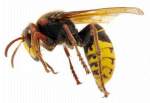
1213009204 |
64k | Tommy Trampp | ||
 |
110k | Warships of the sailing navy. Chromolithograph by Armstrong & Company, after an 1893 watercolor by Fred S. Cozzens, published in Our Navy
-- Its Growth and Achievements, 1897. Ships depicted are from different eras, and are identified by the artist as (from left to right):
US. Brig (Schooner) Enterprise (1799-1823), firing a salute;
U.S. Ship of the Line Pennsylvania (1837-1861);
U.S. Ship of the Line North Carolina (1825-1867), mis-labeled by the artist as South Carolina; and
U.S. Brig Hornet (1805-1829). The vessel under sail in the far center distance is not identified. Collection of Captain Glenn
Howell, USN, 1974. US Naval History and Heritage Command Photo #: NH 460-KN (Color) |
Robert Hurst | |
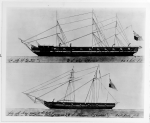 |
209k | USS Hornet (III), (1805-1829) at top, and USS Grampus (I) (1821-1843) at bottom. Sketches of hulls and rigging (with the
latter out of scale to the hulls), by William A.K. Martin, circa 1843 or later. Both vessels, which were lost at sea with all hands, are depicted flying their National
Ensigns upside down, a sign of distress. US Naval History and Heritage Command Photo # NH 86236 |
Robert Hurst | |
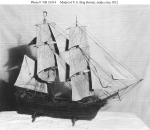 |
86k | USS Hornet rigged model, made circa 1812. Hornet was converted from brig to ship rig in 1811. US Naval History and Heritage Command photo # NH 53414 Courtesy Anderson Galleries, New York. |
US Naval History and Heritage Command | |
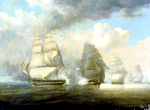
098652211 |
143k | Photo of an oil painting by William John Huggins (1781 – 19 May 1845), depicting the escape of
HMS Belvidera, 23 June 1812.
On the left of the picture Belvidera runs on a very broad reach. She has shot holes in her sails and can be seen firing her stern guns.
Astern of her
USS President can be seen repeatedly firing her starboard broadside. To the right of her, and in pursuit, are
USS Congress,
USS United States,
USS Hornet and
USS Argus.
National Maritime Museum, Greenwich, London. BHC0598. |
Robert Hurst | |
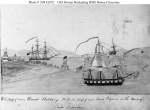 |
105k | Artwork depicting USS Hornet (foreground) off São Salvador (Bahia), Brazil, with the British sloop of war HMS Bonne
Citoyenne blockaded inside the harbor, circa 13 December 1812 - 24 January 1813. Hornet's Commanding Officer, James Lawrence, had challenged the
enemy warship to a single-ship action, but Bonne Citoyenne, which carried a significant amount of money, declined the offer. The original was in a journal
kept by William H. Macy of a whaling voyage to the Pacific Ocean in the ship Potomac, 1841-1845.
US Naval History and Heritage Command photo # NH 42072 Courtesy Charles H. Taylor, 1936. |
US Naval History and Heritage Command | |
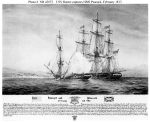 |
141k | Artwork depicting HMS Peacock's mainmast collapsing at the close of her engagement with USS Hornet Text at bottom of image "February 24 1813" "At 3.30 p.m. while beating round Caroband bank, the Hornet discovered a sail on her weather quarter bearing down for her. This was the British brig-sloop Peacock of 16 24 pdr. carronades and 2 sixes, Captain William Peake, who had only sailed from Demerara at 10 a.m. At 4.20 Peacock hoisted her colors and at 5.10 having kept close to the wind to weather the Peacock, the Hornet tacked for that purpose and hoisted her colors. At 5.25 pm the ship and brig exchanged broadsides, within half pistol shot. The Peacock then wore to renew the action on the other tack, the Hornet quickly bearing up, received Peacock's starboard broadside, then ran the latter close aboard on the starboard quarter. The Hornet then poured in so heavy and well directed fire, that at 5.50, having had her commander killed, and being with six feet of water in the hold, and cut to pieces in hull and masts, the Peacock hoisted from her fore-rigging an ensign, union down as a signal of distress. Shortly afterwards her mainmast went by the board. Both Hornet and Peacock were immediately anchored, and every attempt made to save the latter, by throwing her guns overboard, by pumping and bailing her, and stopping such shot holes as could be got at; but all would not do, and in a very few minutes after she had anchored, Peacock went down in 5½ fathoms, with 13 of her men, four of whom afterwards got to the foretop and escaped, as well as 3 men belonging to the Hornet. An American lieutenant and midshipman, and the remainder of the Hornet's men on board the Peacock, with difficulty saved themselves by jumping, as the brig went down, into a boat which was lying on her booms. Four of the Peacock's men had just before taken to her stern boat, in which notwithstanding it was much damaged by shot, they arrived safely at Demerara." US Naval History and Heritage Command photo # NH 42073 |
Tommy Trampp | |
 |
128k | Engraving of the medal authorized by the United States Congress in honor of Captain Lawrence's 24 February 1813 victory in the action
between USS Hornet and HMS Peacock. The Congress ordered a gold version of the medal and requested that the President present it to his nearest
male relative. A silver version was presented to each commissioned officer who served under him in Hornet. The engraving was published in Lossing's
"Field Book, War of 1812", page 700. US Naval History and Heritage Command Photo # NH 1392 |
Robert Hurst | |
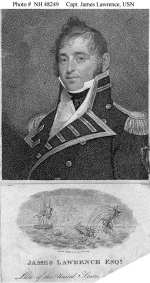 |
155k | Image of Captain James Lawrence, USN (1781-1813) and a stipple engraving by David Edwin, after Gilbert Stuart, printed with a line engraving
by Francis Kearny depicting HMS Peacock sinking after she was captured by USS Hornet, under Lawrence's command, on 24 February 1813. US Naval History and Heritage Command Photo # NH 48249 |
Robert Hurst | |
 |
76k | USS Hornet and HMS Penguin, 23 March 1815. Sketch by Fred S. Cozzens, 1892, copied from his 1897 book "Our Navy --
Its Growth and Achievements". It depicts Hornet, at left, firing on the British brig sloop Penguin during the early part of the engagement. US Naval History and Heritage Command Photo # NH 74523 |
Robert Hurst | |
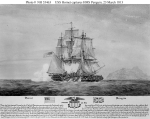 |
123k | USS Hornet captures HMS Penguin, 23 March 1815. Colored lithograph by S. Walters , after a sketch by William Skiddy,
depicting the two sloops close aboard during the engagement, which took place in the South Atlantic off Tristan d'Acunha. Note that the erroneous date of 23 January 1815
appears on the print. Courtesy of the U.S. Naval Academy Museum, Annapolis, Maryland. Beverly R. Robinson Collection. US Naval History and Heritage Command Photo # NH 55463 |
Robert Hurst | |
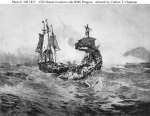 |
131k | USS Hornet in action with HMS Penguin, 23 March 1815. Halftone reproduction of an artwork by Carlton T. Chapman, depicting
the capture of HMS Penguin by USS Hornet off Tristan da Cunha, in the South Atlantic. US Naval History and Heritage Command Photo # NH 1867 |
Robert Hurst | |
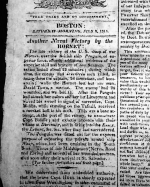 |
161k | Newspaper article from the Boston Patriot, July 8, 1815, "Another Naval Victory by the HORNET". USS Hornet captures HMS Penguin in a battle off Tristan da Cunha. | Tommy Trampp | |
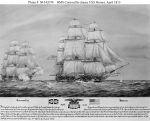 |
123k | Artwork depicting the British 74 gun ship HMS Cornwallis (at left) chasing the US sloop of war USS Hornet in the South Atlantic, as the latter's crew throws overboard spare spars, guns and other items in an effort to increase her speed. US Naval History and Heritage Command photo # NH 42074 Courtesy of Mr. Beverly R. Robinson, March 1937. |
US Naval History and Heritage Command | |
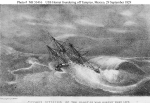 |
189k | Lithograph by Imbert, published in "The Sailors Magazine" March 1830. It depicts USS Hornet foundering off Tampico, Mexico, on 29 September 1829. US Naval History and Heritage Command photo # NH 53416 |
US Naval History and Heritage Command | |
USS Hornet (III)
Dictionary of American Naval Fighting Ships (DANFS)
| Back To The Navsource Photo Archives Main Page | Back To The Old Navy" Steam and Sail Index |
| Comments, Suggestions, E-mail Webmaster. |
|
This page is created and maintained by Gary P. Priolo |